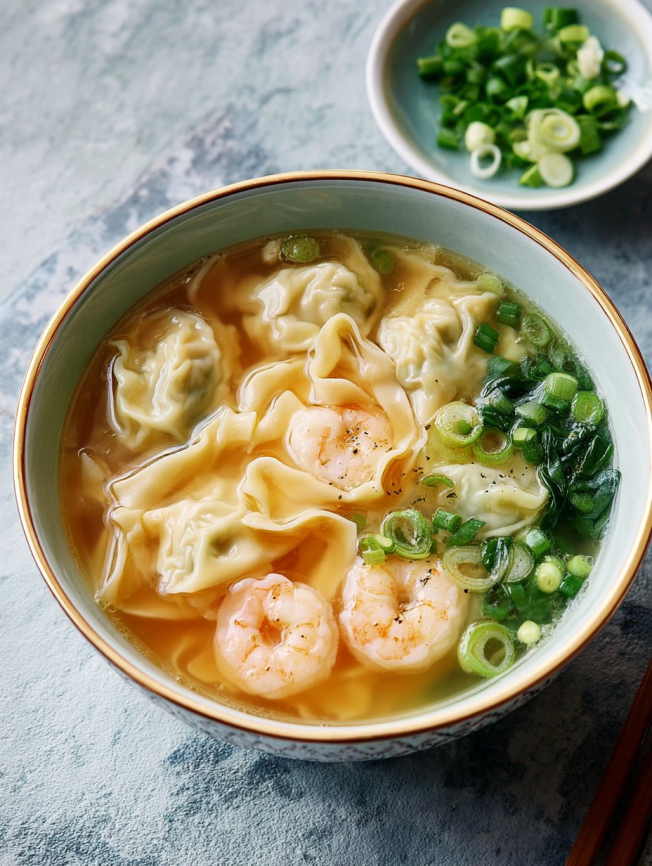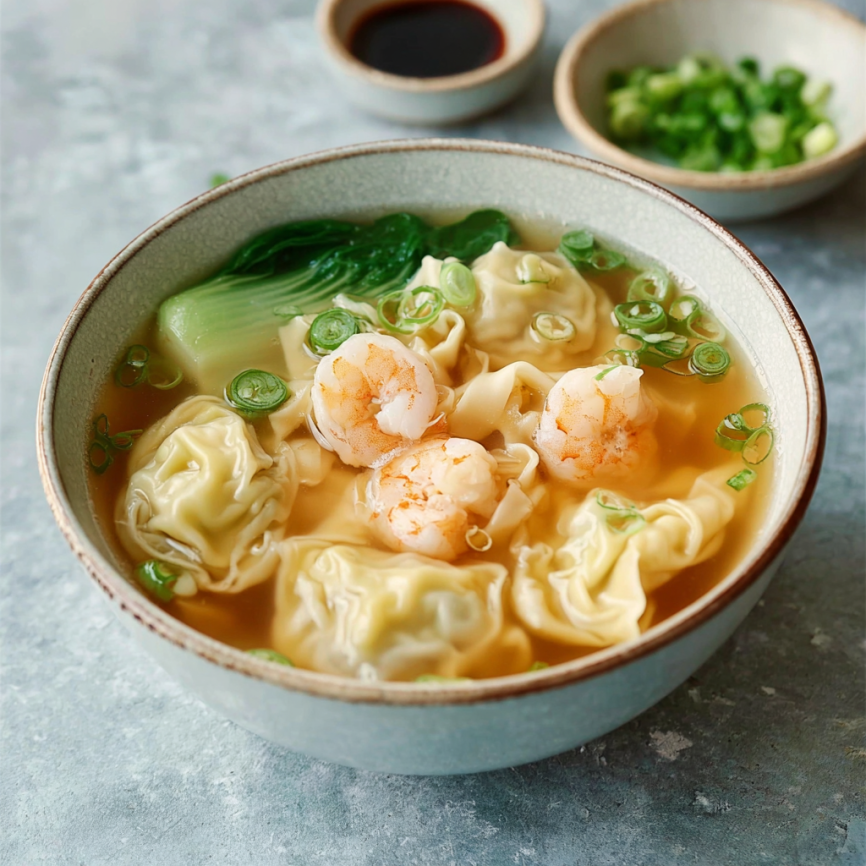My obsession with authentic wonton noodle soup began during a transformative trip to Hong Kong, where I discovered a tiny hole-in-the-wall shop tucked away in a narrow Mong Kok alley. The elderly proprietor, who had been perfecting his craft for over four decades, served me a bowl that changed my understanding of what comfort food could be. Each wonton was impossibly delicate yet bursting with flavor, the noodles had an almost musical bounce, and the broth was so clear yet so deeply satisfying that I found myself returning every single day of my visit. Upon returning home, I became determined to recreate this magical experience in my own kitchen, embarking on a journey that taught me not just about cooking technique, but about the profound connection between food, tradition, and soul-deep satisfaction.
Why This Wonton Noodle Soup Will Captivate Your Heart
Cantonese wonton noodle soup represents the pinnacle of balanced cooking, where every element serves a specific purpose in creating culinary harmony. Unlike heavy Western soups that rely on cream or thick broths, this dish achieves incredible depth through careful layering of subtle flavors and contrasting textures.
The beauty lies in its deceptive simplicity. What appears to be a straightforward soup actually requires masterful technique to achieve the perfect bounce in the noodles, the silky texture of hand-wrapped wontons, and the crystal-clear yet intensely flavorful broth that serves as the foundation.
Furthermore, this recipe offers incredible versatility for home cooks of all skill levels. While traditionalists may spend hours perfecting their wonton folding technique, beginners can achieve delicious results with basic folding methods, gradually improving their skills over time.
Additionally, wonton noodle soup provides exceptional nutritional balance. The lean pork and shrimp filling delivers high-quality protein, while the egg noodles provide satisfying carbohydrates. Meanwhile, the fresh vegetables add vitamins and fiber, creating a complete meal that nourishes both body and spirit.
Essential Ingredients for Authentic Flavor
Wonton Filling Components
- 1/2 pound ground pork – Choose a mix with some fat content for juicy, flavorful wontons
- 1/2 pound shrimp, peeled and chopped – Fresh shrimp adds sweetness and textural contrast
- 2 tablespoons soy sauce – Provides umami depth and helps bind the filling
- 1 tablespoon Shaoxing wine – Essential Chinese cooking wine that adds complexity
- 1 tablespoon sesame oil – Contributes nutty aroma and authentic flavor
Seasoning Elements
- 1/2 teaspoon white pepper – Gentler than black pepper, traditional in Cantonese cooking
- 1 tablespoon finely chopped scallions – Adds freshness and mild onion flavor
- 1 teaspoon grated ginger – Provides warmth and helps balance the seafood
Soup Base Essentials
- 4 cups chicken stock – Forms the flavorful foundation; homemade preferred
- 2 cups water – Dilutes the stock to proper consistency
- 1 tablespoon light soy sauce – For gentle seasoning without darkening the broth
- 1/2 teaspoon salt – Enhances all other flavors
Additional Components
- 30 wonton wrappers – Look for thin, square wrappers at Asian markets
- 4 portions egg noodles – Fresh alkaline noodles provide the characteristic bounce
- Choi sum or bok choy – Traditional leafy vegetables for color and nutrition
Step-by-Step Preparation Guide
Creating the Perfect Wonton Filling
Begin by combining ground pork, chopped shrimp, soy sauce, Shaoxing wine, sesame oil, white pepper, scallions, and grated ginger in a large mixing bowl. Mix the ingredients gently but thoroughly, taking care not to overwork the mixture, which could result in tough wontons.
Allow the filling to rest for 15 minutes, permitting the flavors to meld while you prepare your workspace for wrapping. This resting period also helps the mixture hold together better during the folding process.
Mastering Wonton Wrapping Technique
Place approximately one teaspoon of filling in the center of each wrapper, avoiding overfilling which can cause bursting during cooking. Lightly wet the edges with water using your finger or a small brush.
Fold the wrapper diagonally to create a triangle, pressing gently to remove air bubbles and seal the edges completely. Next, bring the two bottom corners of the triangle together, overlapping them slightly and sealing with a small dab of water to create the classic wonton shape.
Building the Aromatic Broth
In a large pot, combine chicken stock and water, bringing the mixture to a gentle boil over medium-high heat. Season carefully with light soy sauce and salt, tasting and adjusting as needed to achieve the perfect balance of savory and subtle flavors.
The key to exceptional broth lies in maintaining clarity while developing depth. Avoid vigorous boiling, which can cloud the broth, and skim any impurities that rise to the surface during heating.
Final Assembly Process
Cook wontons in batches to prevent overcrowding, dropping them into the simmering broth for 4-5 minutes until they float and are cooked through. Remove with a slotted spoon and set aside.
Meanwhile, cook egg noodles according to package instructions in a separate pot. Drain thoroughly, rinse briefly with cold water to stop cooking, then reheat quickly in hot water just before serving to ensure optimal texture.

Traditional Serving Presentation
Arrange the cooked noodles in individual bowls as the base layer, creating a nest-like shape that will hold the other components beautifully. Place 6-8 wontons artfully on top of the noodles, distributing them evenly around each bowl.
Blanch the choi sum or bok choy quickly in boiling water until bright green and tender-crisp, then arrange alongside the wontons for color contrast and nutritional balance.
Ladle the hot, clear broth over each serving, ensuring it covers the noodles and wontons completely. The broth should be steaming hot to maintain the proper serving temperature throughout the meal.
Garnish each bowl with freshly chopped scallions and serve immediately with traditional accompaniments such as chili oil, white pepper, and light soy sauce on the side.
Delicious Recipe Variations
Luxurious Seafood Version
Replace the pork with additional shrimp and add finely diced water chestnuts for extra crunch. Include a small amount of crab meat in the filling for special occasions, creating an elevated version perfect for celebrations.
Vegetarian Alternative
Substitute the meat filling with a mixture of finely chopped mushrooms, water chestnuts, and seasoned tofu. Use vegetable stock as the broth base while maintaining all the traditional seasonings for authentic flavor.
Spicy Sichuan Style
Add a tablespoon of chili oil and a pinch of Sichuan peppercorns to the broth for those who enjoy heat. This variation maintains the soup’s essential character while adding exciting regional flavors.
Premium Restaurant Style
Use superior stock made from chicken bones, dried scallops, and Chinese ham for extraordinary depth. Add a few drops of supreme soy sauce and garnish with fresh coriander for restaurant-quality presentation.
Smart Make-Ahead Strategies
Prepare wontons up to one day in advance, storing them on parchment-lined trays in the refrigerator. Cover tightly with plastic wrap to prevent drying, and dust lightly with cornstarch to prevent sticking.
For longer storage, freeze wrapped wontons on trays until solid, then transfer to freezer bags where they’ll keep for up to three months. Cook frozen wontons directly from the freezer, adding an extra minute to the cooking time.
Broth can be prepared up to three days ahead and actually improves in flavor during storage. Cool completely before refrigerating, and remove any solidified fat from the surface before reheating.
However, cook noodles fresh each time you serve the soup, as they become soggy and unappetizing when stored. The entire assembly process takes only minutes when components are prepped ahead.
Professional Techniques and Cultural Notes
Wrapper Selection: Authentic wonton wrappers are thinner than dumpling skins and create more delicate results. Yellow egg-based wrappers are traditional, though white versions work acceptably.
Filling Texture: The ideal filling combines smooth ground pork with chunks of shrimp for textural interest. Chop shrimp by hand rather than using a food processor to maintain proper consistency.
Broth Clarity: Professional chefs achieve crystal-clear broth by starting with cold water, bringing it slowly to temperature, and carefully skimming impurities. Never allow vigorous boiling, which creates cloudiness.
Noodle Preparation: Fresh alkaline egg noodles (竹昇麵) are traditional and provide the characteristic yellow color and springy texture. Cook them just until tender, as they’ll continue cooking slightly in the hot broth.
Cultural Etiquette: In Hong Kong, wonton noodle soup is often eaten quickly while hot, and slurping is not only acceptable but encouraged as it helps cool the noodles and enhances flavor perception.

Frequently Asked Questions
Can I use store-bought wontons instead of making them from scratch? While homemade wontons provide superior flavor and texture, quality frozen wontons from Asian markets make acceptable substitutes for busy weeknights. Look for brands with visible shrimp pieces and avoid those with excessive fillers or artificial ingredients.
Why do my wontons fall apart during cooking? Wonton breakage usually results from inadequate sealing or overfilling. Ensure wrapper edges are properly moistened and pressed firmly together, removing all air bubbles. Additionally, avoid boiling too vigorously, which can cause delicate wrappers to burst.
How do I achieve the characteristic bounce in the noodles? Authentic bounce comes from using fresh alkaline egg noodles and proper cooking technique. Don’t overcook the noodles, and rinse them briefly with cold water after cooking to stop the cooking process. Reheat quickly in hot water just before serving.
What’s the secret to crystal-clear broth? Clear broth requires patience and proper technique. Start with cold liquid, heat slowly, and skim continuously. Avoid vigorous boiling and don’t stir excessively. Some chefs clarify broth using egg whites, though this isn’t necessary for home cooking.
Can I make this soup less time-consuming? Absolutely! Use quality store-bought chicken stock, purchase pre-made wontons, and buy fresh noodles from Asian markets. This reduces preparation time significantly while maintaining authentic flavors. Focus your efforts on proper assembly and seasoning.
How do I store leftover soup? Store components separately for best results. Keep broth, wontons, and noodles in separate containers for up to three days. Reheat gently and cook fresh noodles when serving leftovers, as stored noodles become mushy and unappetizing.

